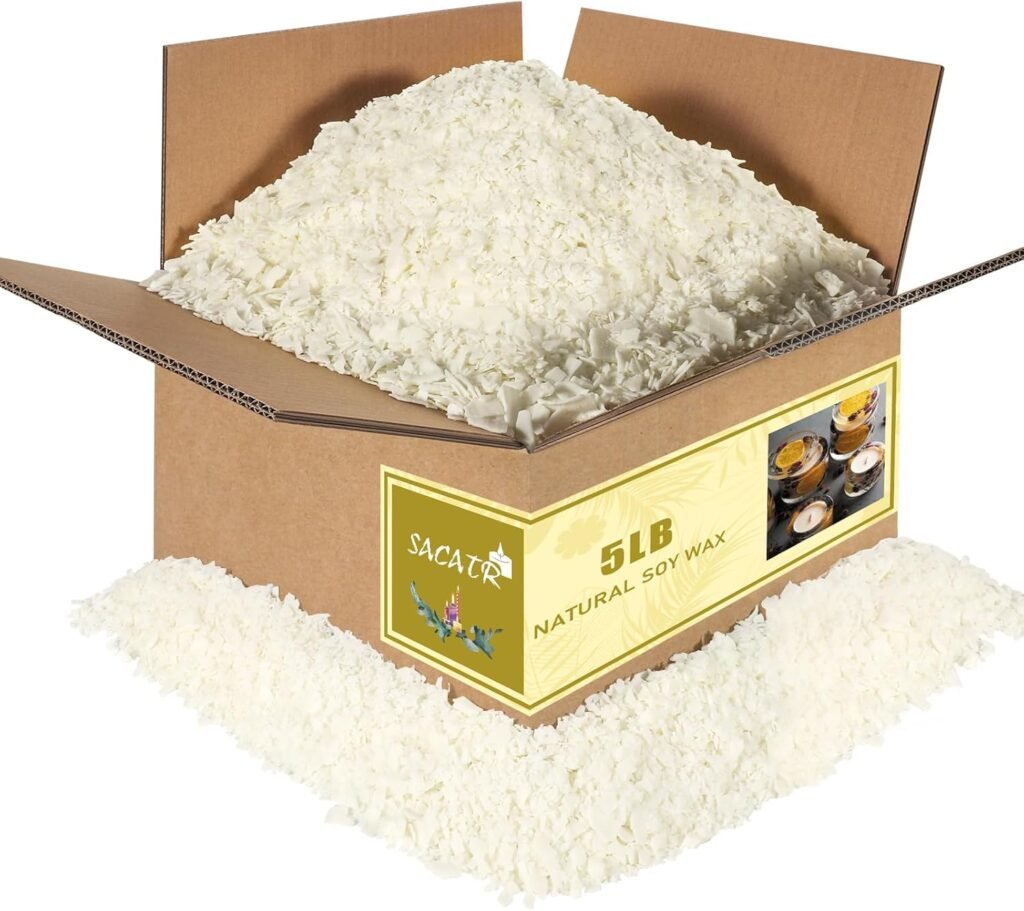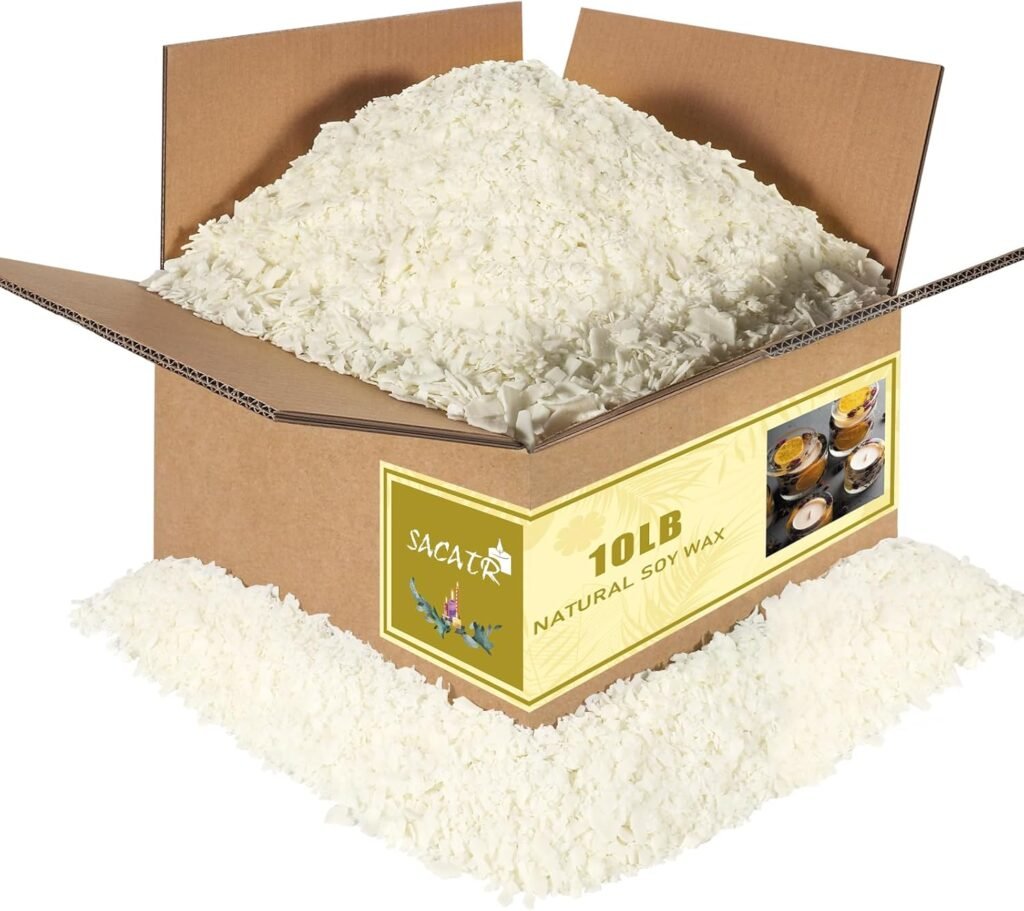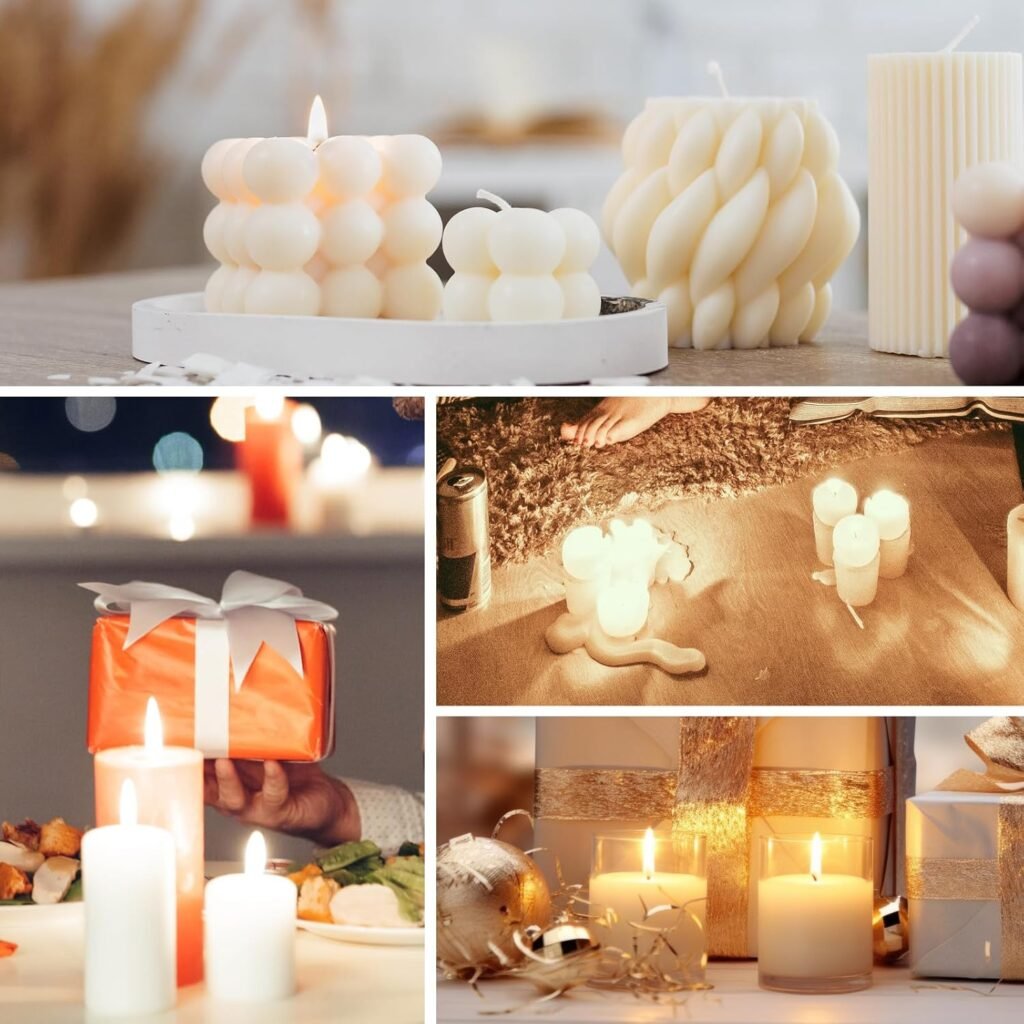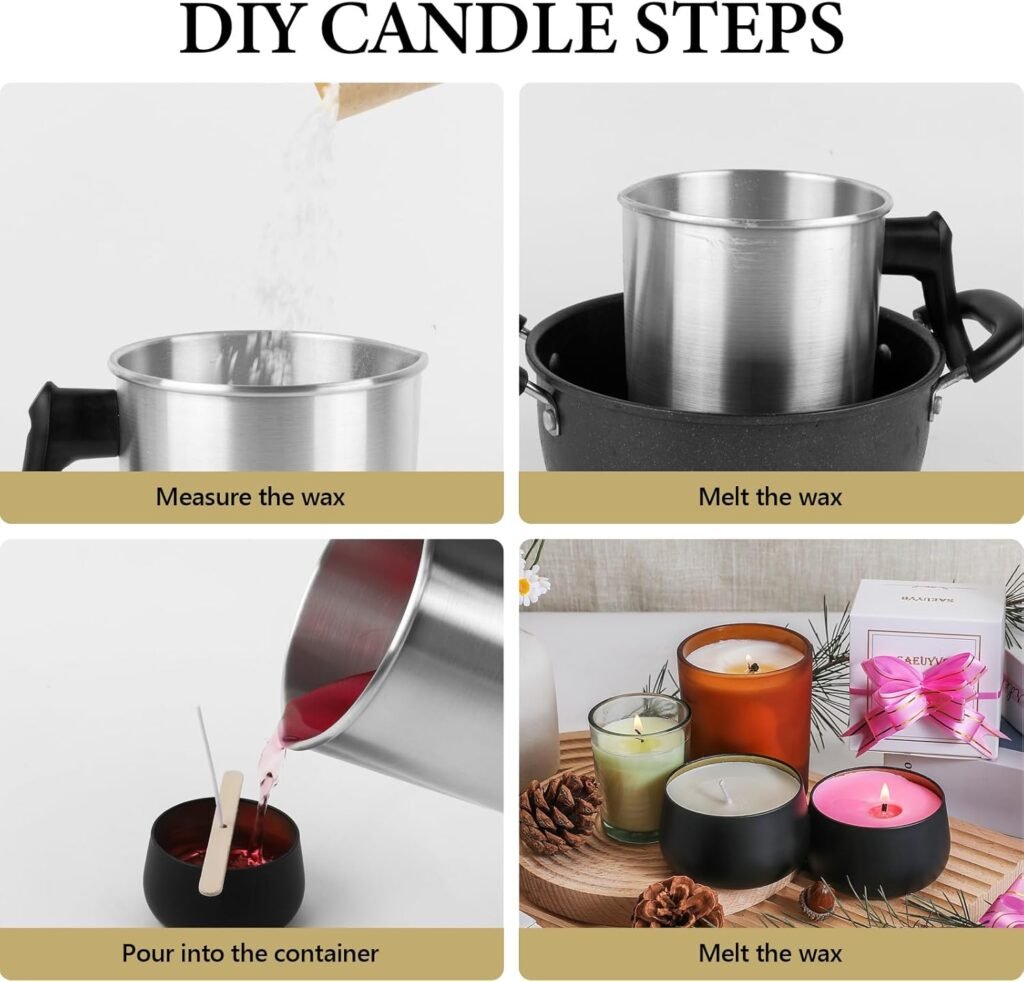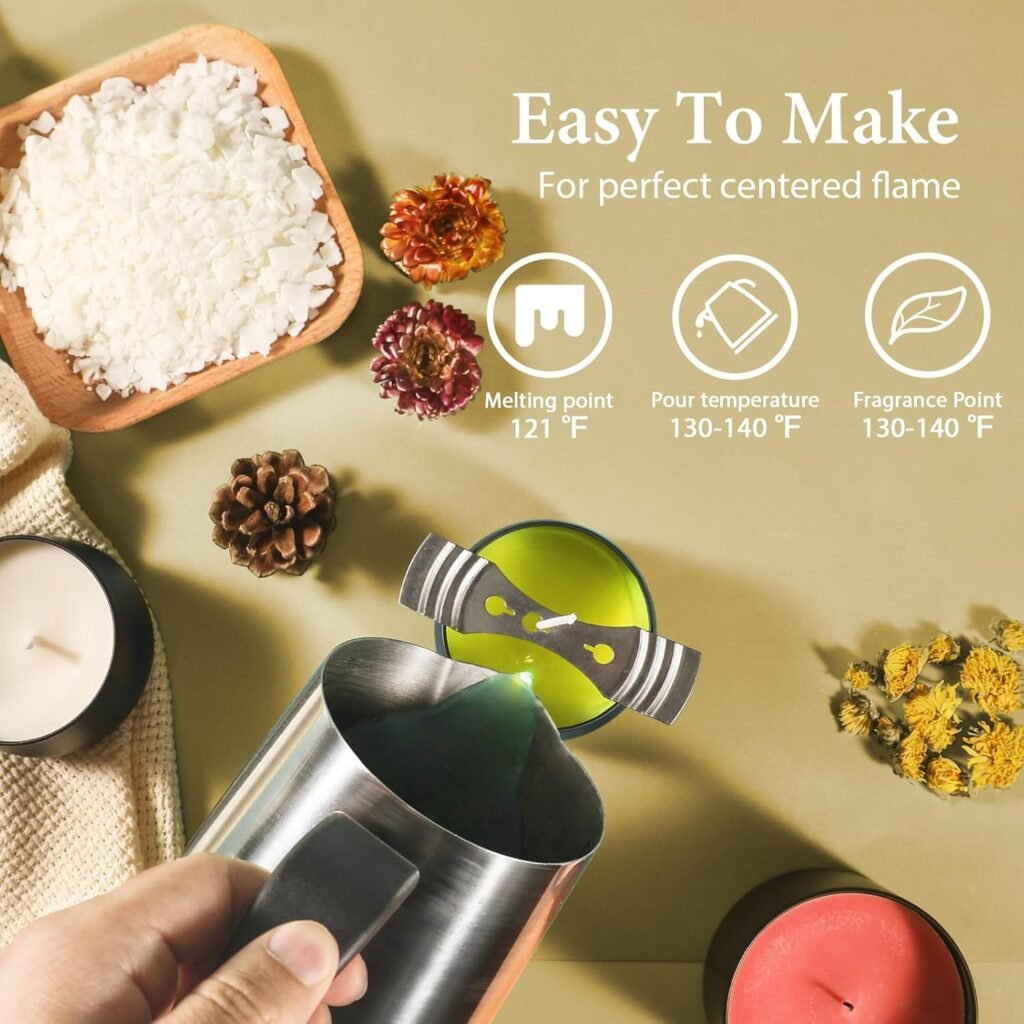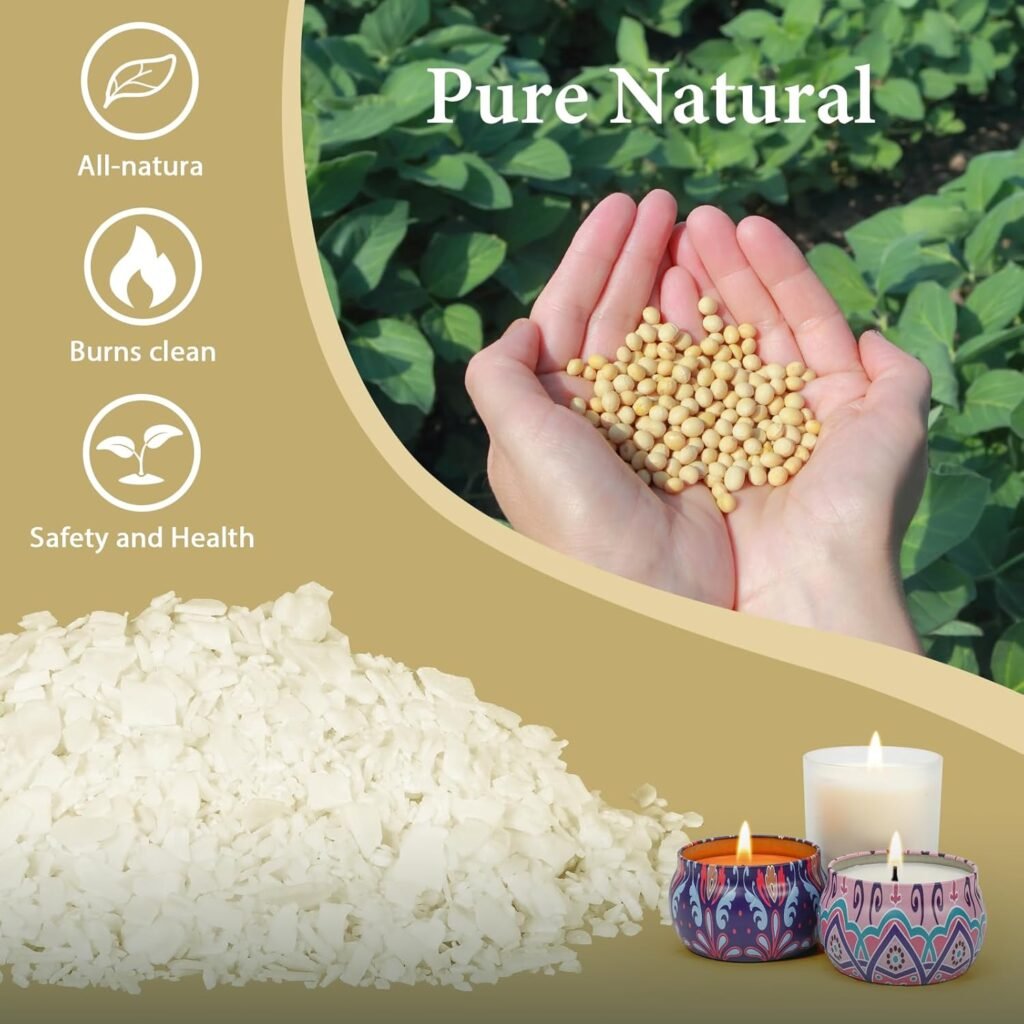Have you been looking for a clean, easy-to-use soy wax that helps you make beautiful candles at home?
Product Overview
You’ll find the SACATR 5LB Soy Wax for Candle Making, 100% Soy Wax – Natural Candle Wax- No additives and Pure, Premium Quality Candle Wax for Candle Making is aimed at hobbyists and small-batch makers who want a simple, natural base for scented candles. This wax is marketed as pure soy with no additives, promising even burning, cleaner smoke, and an easier scent experience compared with paraffin-based options. You can expect a straightforward product focused on container candles and beginner-friendly projects.
What the Product Promises
The product description emphasizes that the wax is 100% soy, burns more cleanly, and lacks the unhealthy chemicals associated with paraffin wax. It also provides simple temperature guidance for melting, mixing, and adding dyes or fragrances. You’ll appreciate that the packaging positions this wax as suitable for both beginners and more experienced makers who want a consistent base for scented candles.
Who This Is For
If you make candles at home for gifting, small business use, or hobby crafting, this wax is pitched directly at you. It’s particularly helpful if you prefer natural ingredients and want a wax that mixes well with fragrance oils and dye without extra fillers. Because it’s a pure soy product, customers who prioritize cleaner-burning, renewable materials will likely prefer it over paraffin.
Key Specifications
You’ll find it useful to compare the main attributes at a glance. Below is a compact reference table to help you understand what you’re getting.
| Attribute | Details |
|---|---|
| Product Name | SACATR 5LB Soy Wax for Candle Making, 100% Soy Wax – Natural Candle Wax- No additives and Pure, Premium Quality Candle Wax for Candle Making |
| Weight/Size | 5 lb (approx. 2.27 kg) |
| Composition | 100% soy wax (no additives claimed) |
| Intended Use | DIY container candles, scented candles, craft projects |
| Melting / Mixing Guidance | Mix at 120 degrees; add dyes or scents at 180 degrees (185 degrees if dyes don’t fully melt) — see notes below about units and safety |
| Promised Results | Smooth tops, consistent scent distribution, clean burn |
| Audience | Beginners and experienced candle makers |
You’ll want to keep the temperature guidance in mind but also confirm whether those temperatures are given in Fahrenheit or Celsius for your region. Most candle instructions use Fahrenheit, so adjust accordingly.
Performance and Burn Quality
When you use this soy wax, you’ll likely notice a relatively even burn and a calm, clean flame if you wick properly. Because it’s formulated to be additive-free, you should see less sooty residue compared with paraffin candles, and the overall burn will feel more natural and less chemically scented.
Soy wax typically gives a longer burn time per ounce than paraffin, so you’ll get good value for longer-burning candles. With correct wick selection and proper curing, you should achieve consistent scent release and minimal smoking.
Scent Throw and Fragrance Compatibility
You’ll want to think about both cold throw (scent when unlit) and hot throw (scent when burning). This soy wax mixes readily with fragrance oils, and many users report good hot throw when using recommended fragrance loadings. For most fragrance oils, a load between 6% and 10% by weight is a good starting point; many soy wax makers aim for around 8% for a balanced hot throw without overloading the wax.
Because this wax is pure soy, some very light fragrance oils might read or fade more quickly, while more concentrated or citrus-friendly oils may require testing. You’ll achieve the best results by experimenting with small test batches to find the right fragrance percentage for the specific oil you use.
Ease of Use
This product is sold with beginner-friendly instructions and straightforward handling. You’ll appreciate how clean the wax is when melting and pouring; it tacks and sticks less than some blends, and cleanup is simpler—hot water, mild detergent, and a sponge will usually remove residues from tools.
The manufacturer’s suggested temperature steps are a helpful starting point, and you should always use a reliable thermometer (or digital probe) to follow safe and accurate practices. The wax’s behavior is predictable, which makes it great for learning wick selection and curing times.
Melting and Pouring Temperatures
The product text states: “Simply melt them down and mix at 120 degrees to get started; if you want to add dyes or scents, raise the temperature to 180 degrees (or 185 degrees if the dyes do not fully melt).” You’ll want to interpret these temperatures using your local convention (most candle makers in the U.S. use Fahrenheit). In general practice, here’s a safe and practical workflow you can use with this wax:
- Heat the wax until fully melted, typically around 170–185°F (76–85°C) to ensure all crystals are dissolved.
- If you need to incorporate solid dye or certain fragrance oils, add them near the higher melt temperature (around 180–185°F or as the product suggests).
- Allow the wax to cool to a recommended pour range—often between 120–140°F (49–60°C) depending on container size—before pouring to minimize sinkholes and cracking.
You’ll reduce mistakes by using a reliable thermometer and noting your ambient room temperature and container material, because those factors influence optimal pour temperature.
Dye and Scent Tips
You’ll find this wax responsive to most candle dyes and liquid fragrance oils, but a few practical tips will improve your final candles. If you use dye blocks or chips, pre-melt them in a small amount of wax or add them at higher temperatures to ensure complete dissolution. For liquid dyes, a single drop may go a long way—start small and increase incrementally.
When adding fragrance, measure by weight rather than volume for more consistent results. If you’re testing a new fragrance, make a small 4–8 oz test candle to evaluate cold and hot throws before committing to larger batches. You’ll avoid wasted wax and learn the sweet spot for scent load more quickly.
Recommended Fragrance Loads and Timing
You’ll want to follow these general parameters:
- Light scents: 6–8% fragrance load by weight.
- Stronger or complex scents: 8–10% fragrance load by weight.
- Add fragrance at or near 180°F to help the oil bind into the wax effectively, then stir thoroughly for at least 1–2 minutes for a good mix.
Testing is key: fragrances behave differently in soy than in paraffin, so you’ll learn by measuring, labeling, and curing samples.
Wicking Recommendations
Your wick is the single most important factor for a clean, even burn. You’ll need to match wick size and type to the diameter of the container and the fragrance load you use. For example, a small 2–3 inch diameter container often takes a smaller cotton or cotton-core wick, whereas wider jars require larger or multiple wicks.
Start with manufacturer-suggested wick charts if you have them, and always do a burn test: burn a candle for a few hours to see the melt pool and adjust wick size if you see tunneling, excessive smoking, or a flame taller than 0.5–0.75 inches. You’ll save time by pre-testing wicks before committing to large batches.
Wick Types to Consider
You’ll typically choose between:
- Flat braided cotton wicks — common and reliable for many container sizes.
- Square or cored cotton wicks — better for larger diameters and stronger fragrance loads.
- Wooden wicks — aesthetic and give a crackling sound, but demand careful testing for consistent melt pools.
Whichever wick you pick, center it securely and ensure proper adhesion at the base to prevent wobble or tilting while curing.
Candle Types You Can Make
This wax is ideal for container candles (jars, tins, glasses) where pure soy performs exceptionally well. You’ll be able to craft scented jar candles, votives in small molds, wax melts/tarts for warmers, and decorative layered candles with color or embed techniques.
Because it’s 100% soy with no additives, you should be cautious about expecting the same hardness as pillar or taper waxes. Pure soy tends to be softer and may require a blend or additive if you want to make dripless pillars or freestanding shapes. For most home projects, container candles will be your best result with this wax.
Beginner-Friendly Project: Simple 8 oz Jar Candle
You’ll get comfortable with this wax after a few small projects. Here’s an approachable step-by-step you can follow.
Materials:
- SACATR 5LB Soy Wax (amount based on jar size)
- 8 oz glass jar with lid
- Appropriate wick (cotton or cored, pre-tabbed)
- Fragrance oil (8% of the wax weight recommended as a starting point)
- Thermometer and double boiler or melter
- Scale and stirring utensil
Steps:
- Weigh the wax necessary for your jar. For an 8 oz jar you’ll need around 6–7 oz wax by weight (jar and fill density varies).
- Melt the wax in a double boiler until fully liquid. Aim to reach ~175–185°F for a full melt.
- If using dye, add at the appropriate temperature (per the product guidance) and stir until dissolved.
- Remove from heat and cool slightly. Add fragrance oil at around 180°F (or follow your scent’s recommendation), stirring for at least 1–2 minutes to blend well.
- Let the wax cool to a pour temperature between 120–140°F, then carefully pour into the jar around a centered wick.
- Allow to cure undisturbed for 24–48 hours. Trim wick to 1/4 inch before burning for the first time.
You’ll see steady results by following these steps and making small tweaks for wick size and fragrance load as needed.
Troubleshooting Common Issues
You’ll encounter a few predictable problems as you work with soy wax, but most are fixable with minor adjustments.
- Frosting (white crystalline surface): This natural effect is common with soy. You can reheat and smooth the surface lightly or accept it as a sign of natural soy. Frosting doesn’t affect burn performance.
- Sinkholes or wet spots: These can form at the center after cooling. A top-up pour — reheating a small batch of wax and filling sinks shortly after initial set — often fixes the issue.
- Poor scent throw: Increase fragrance load incrementally and consider slightly higher pour temperatures for better oil binding. Also ensure sufficient cure time (typically 48–72 hours or more for full hot throw).
- Tunneling (wax burns down center only): Try a larger wick and perform an initial burn long enough to create a full melt pool across the entire diameter of the candle (usually 1 hour per inch of diameter).
You’ll reduce the frequency of these issues by keeping detailed notes for each batch (temperature, fragrance %, wick, container size, ambient temp) so you can replicate success.
Safety and Storage
You’ll handle hot wax and flammable fragrance oils, so prioritize safety. Use a stable double boiler or dedicated melting pot, never leave melting wax unattended, and keep a fire extinguisher nearby suitable for oil/grease fires (Class B). Avoid water on large wax fires.
For storage, keep the 5 lb block in a cool, dry place away from direct sunlight and strong odors, which can be absorbed by the wax. You’ll extend the shelf life and keep consistent performance by storing in sealed containers or original packaging.
Sustainability and Environmental Notes
Soy wax is derived from soybeans, a renewable agricultural product, and generally produces less soot than paraffin. You’ll like that it’s a biodegradable option and often considered more environmentally friendly than petroleum-based waxes. That said, the product does not specify certifications like non-GMO or organic; if those attributes matter to you, check the seller’s full listing or ask directly for sourcing details.
Because it burns cleaner, you’ll find it better for indoor air quality than paraffin, though any scented candle generates particles — so use in well-ventilated rooms and trim wicks to minimize soot.
Comparison with Paraffin and Blended Waxes
When choosing a wax, you’ll notice specific differences:
- Paraffin: Strong cold and hot throw, harder wax, cheaper price point, higher soot.
- Soy (this product): Cleaner burn, longer burn time per ounce in many cases, natural origin, softer wax (better for containers).
- Soy blends: May add stearic or coconut to harden the wax for pillars or improve scent throw.
You’ll want to pick this pure soy wax if you prefer a natural ingredient list and are primarily making container candles. If you want very hard pillars or intensely strong cold throw right away, you might consider blends or additives.
Value and Packaging
A 5 lb block is a practical size that balances cost savings and manageable handling for home crafters. You’ll get enough wax for multiple mid-sized candles, which helps reduce per-candle cost compared with small packaged amounts. Packaging quality matters: look for secure, sealed bags or boxes to prevent contamination or moisture exposure during shipping.
If you’re selling candles, factor in the cost of fragrance, wicks, containers, labels, and shipping when calculating final candle pricing. This wax presents a strong value when you care about natural ingredients and a predictable burn.
Tips to Get the Best Results
You’ll get the most consistent performance by following these habits:
- Use a digital thermometer and log temperatures when you melt, add fragrance, and pour.
- Label each test candle with the recipe: wax amount, fragrance percent, wick size, pour temp, and cure time.
- Cure candles for 48–72 hours (or longer for maximum hot throw) before evaluating scent performance.
- Start tests with smaller batch sizes to refine your process before scaling up.
- Keep your workspace clean; residual fragrance or dust can affect scent and appearance.
These steps will help you standardize production and reduce surprises as you scale up.
Pros and Cons Summary
You’ll find a quick snapshot helpful when deciding whether to buy.
Pros:
- Natural, 100% soy composition for cleaner burning and renewable sourcing.
- Beginner-friendly with simple temperature instructions and predictable behavior.
- Good compatibility with fragrances and dyes for container candles.
- 5 lb size gives decent value-per-pound for hobbyists and small makers.
Cons:
- Pure soy without additives is softer, so it’s not ideal for freestanding pillars or waxes needing extra hardness.
- Temperature instructions in the product text may require interpretation by region (F vs C), so you’ll need to confirm with a thermometer.
- Some fragrances will require testing to achieve desired cold and hot throw levels.
You’ll balance these pros and cons based on the specific candle types you plan to create.
Frequently Asked Questions (FAQ)
You’ll likely have some of these questions as you get started. Below are practical answers.
Q: Is this wax safe for beginners?
A: Yes — the product is designed for easy use. You’ll do best with a thermometer, basic safety equipment, and small test batches to learn behavior.
Q: Can I make pillars with this wax?
A: Pure soy wax is typically softer and better suited for containers. You’ll likely need additives or a soy blend for sturdy pillars.
Q: What fragrance load should I use?
A: Start around 8% by weight and test. Some oils behave better at 6% while others support up to 10%. Always test small batches.
Q: Do I use Fahrenheit or Celsius for the temperature guidelines?
A: The listing gives temperatures but doesn’t specify units. Most candle makers in the U.S. use Fahrenheit, so check your thermometer and local norms. Use care and heat slowly to avoid overheating.
Q: How long should candles cure?
A: Allow at least 48–72 hours for proper curing; some makers prefer up to 2 weeks for optimal hot throw.
You’ll avoid common errors by testing and making small adjustments with each batch.
Troubleshooting Continued: Advanced Fixes
You’ll sometimes need more advanced corrections for stubborn problems.
- Surface Blemishes: If you get mottling or small dimples, a gentle reheat with a heat gun at low setting can level the surface, or perform a top-up pour with slightly warmer wax.
- Separation of Fragrance: If fragrance appears to separate or sink, the fragrance may be too heavy for the wax. Reduce load slightly or swirl the jar immediately after pouring to encourage mixing.
- Discoloration or Cloudiness: This can be caused by certain fragrance oils or impurities; try a small test batch with alternate oil to determine the culprit.
Experimentation and patience will help you master these fixes.
Making This Product Work for Small Businesses
If you plan to sell candles, you’ll appreciate that this wax offers a clean marketing angle: natural, soy-based, and additive-free. You’ll want to refine consistency: ensure jars, labels, and packaging are uniform and that each candle passes a burn test of 2–4 hours to verify wick and scent performance.
Keep records of each batch’s recipe and packaging date so you can answer customer questions about curing and scent potency. You’ll also need to check regulatory labeling requirements in your region for candle ingredients and safety warnings.
Final Verdict
You’ll find SACATR 5LB Soy Wax for Candle Making, 100% Soy Wax – Natural Candle Wax- No additives and Pure, Premium Quality Candle Wax for Candle Making a solid, user-friendly option for container candle projects and hobby crafting. It’s especially appealing if you want a natural, cleaner-burning base that mixes well with fragrances and dyes. With a bit of testing for wick and fragrance load, you’ll be able to produce attractive, well-performing candles for yourself, gifts, or small-scale sales.
Disclosure: As an Amazon Associate, I earn from qualifying purchases.

